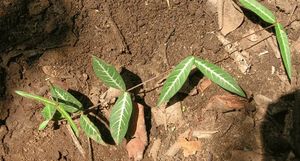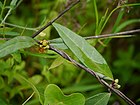Note: This is a project under development. The articles on this wiki are just being initiated and broadly incomplete. You can Help creating new pages.
Difference between revisions of "Hemidesmus indicus - Ananthamoola"
(→External Links) |
|||
| Line 3: | Line 3: | ||
==Uses== | ==Uses== | ||
{{Uses|Gums diseases in teeth}}, {{Uses|Hair fall}}, {{Uses|Dysuria}}, {{Uses|Eye diseases}}, {{Uses|Jaundice}}, {{Uses|Rheumatism}}, {{Uses|Arthritis}}, {{Uses|Body pain}}, {{Uses|Abdominal pain}}, {{Uses|Indigestion}}, {{Uses|Scabies}}, {{Uses|Eczema}}. | {{Uses|Gums diseases in teeth}}, {{Uses|Hair fall}}, {{Uses|Dysuria}}, {{Uses|Eye diseases}}, {{Uses|Jaundice}}, {{Uses|Rheumatism}}, {{Uses|Arthritis}}, {{Uses|Body pain}}, {{Uses|Abdominal pain}}, {{Uses|Indigestion}}, {{Uses|Scabies}}, {{Uses|Eczema}}. | ||
| + | |||
| + | ===Food=== | ||
| + | Hemidesmus indicus can be used in Food Leaves cooked as vegetable and roots used in preparation of tea<ref name="Forest foods of Western Ghat"/>. | ||
==Parts Used== | ==Parts Used== | ||
| Line 28: | Line 31: | ||
Kapha, Pitta | Kapha, Pitta | ||
===Prabhava=== | ===Prabhava=== | ||
| + | |||
| + | ===Nutritional components=== | ||
| + | Hemidesmus indicus Contains the Following nutritional components like - Vitamin-C and E; Alkaloids; Flavanoids; Glycosides; Phytosterols; Phenols; Saponins; Terpenoids; Tannins; Calcium, Iron, Magnesium, Phosphorus, Potassium, Sodium, Zinc<ref name="Nutritional components"/> | ||
==Habit== | ==Habit== | ||
| Line 57: | Line 63: | ||
==How to plant/cultivate== | ==How to plant/cultivate== | ||
| − | The plant can best be propagated from stem and rootstock cuttings obtained from more than one-year-old plants. Rootstock cuttings have better sprouting and survival rates than stem cuttings.<ref name="How to plant/cultivate"/> | + | The plant can best be propagated from stem and rootstock cuttings obtained from more than one-year-old plants. Rootstock cuttings have better sprouting and survival rates than stem cuttings. Hemidesmus indicus is available throughout the year<ref name="How to plant/cultivate"/> |
==Commonly seen growing in areas== | ==Commonly seen growing in areas== | ||
| Line 74: | Line 80: | ||
==References== | ==References== | ||
| − | |||
<references> | <references> | ||
<ref name="chemical composition">[https://scialert.net/fulltextmobile/?doi=jps.2008.146.156 Phytochemicals]</ref> | <ref name="chemical composition">[https://scialert.net/fulltextmobile/?doi=jps.2008.146.156 Phytochemicals]</ref> | ||
| − | |||
<ref name="Leaf">[http://vikaspedia.in/agriculture/crop-production/package-of-practices/medicinal-and-aromatic-plants/hemidesmus-indicus Morphology]</ref> | <ref name="Leaf">[http://vikaspedia.in/agriculture/crop-production/package-of-practices/medicinal-and-aromatic-plants/hemidesmus-indicus Morphology]</ref> | ||
<ref name="Ayurvedic preparations">[https://easyayurveda.com/2013/12/20/sariva-hemidesmus-indicus-benefits-usage-dose-side-effects/ Ayurvedic preparations]</ref> | <ref name="Ayurvedic preparations">[https://easyayurveda.com/2013/12/20/sariva-hemidesmus-indicus-benefits-usage-dose-side-effects/ Ayurvedic preparations]</ref> | ||
| − | |||
<ref name="How to plant/cultivate">[http://vikaspedia.in/agriculture/crop-production/package-of-practices/medicinal-and-aromatic-plants/hemidesmus-indicus Cultivation details]</ref> | <ref name="How to plant/cultivate">[http://vikaspedia.in/agriculture/crop-production/package-of-practices/medicinal-and-aromatic-plants/hemidesmus-indicus Cultivation details]</ref> | ||
| + | <ref name="Forest foods of Western Ghat">"Forest food for Northern region of Western Ghats" by Dr. Mandar N. Datar and Dr. Anuradha S. Upadhye, Page No.89, Published by Maharashtra Association for the Cultivation of Science (MACS) Agharkar Research Institute, Gopal Ganesh Agarkar Road, Pune</ref> | ||
</references> | </references> | ||
Revision as of 12:06, 1 November 2021
Hemidesmus indicus is a climber found throughout India. The plant is widely exploited from the wild for its root, which is used medicinally. Plant populations in some areas have dropped dramatically and the plant is now being experimentally cultivated in India.
Contents
- 1 Uses
- 2 Parts Used
- 3 Chemical Composition
- 4 Common names
- 5 Properties
- 6 Habit
- 7 Identification
- 8 List of Ayurvedic medicine in which the herb is used
- 9 Where to get the saplings
- 10 Mode of Propagation
- 11 How to plant/cultivate
- 12 Commonly seen growing in areas
- 13 Photo Gallery
- 14 References
- 15 External Links
Uses
Gums diseases in teeth, Hair fall, Dysuria, Eye diseases, Jaundice, Rheumatism, Arthritis, Body pain, Abdominal pain, Indigestion, Scabies, Eczema.
Food
Hemidesmus indicus can be used in Food Leaves cooked as vegetable and roots used in preparation of tea[1].
Parts Used
Chemical Composition
Nerolidol (1.2%), borneol (0.3%), linalyl acetate (0.2%), dihydrocarvyl acetate (0.1%), salicylaldehyde (0.1%), isocaryophyllene (0.1%), alpha terpinyl acetate (traces) and 1, 8-cineol (traces) are important as aromatic and bioactive principles[2]
Common names
| Language | Common name |
|---|---|
| Kannada | Sogadeberu |
| Hindi | Anantamul |
| Malayalam | Nannari Narunanti |
| Tamil | Nannari |
| Telugu | Nannari |
| Marathi | NA |
| Gujarathi | NA |
| Punjabi | NA |
| Kashmiri | NA |
| Sanskrit | Nagajihya |
| English | NA |
Properties
Reference: Dravya - Substance, Rasa - Taste, Guna - Qualities, VeNannarierya - Potency, Vipaka - Post-digesion effect, Karma - Pharmacological activity, Prabhava - Therepeutics.
Dravya
Rasa
Tikta (Bitter), Madhura (Sweet)
Guna
Guru (heavy), Snigda (oily)
Veerya
Sheeta (Cold)
Vipaka
Madhura (Sweet)
Karma
Kapha, Pitta
Prabhava
Nutritional components
Hemidesmus indicus Contains the Following nutritional components like - Vitamin-C and E; Alkaloids; Flavanoids; Glycosides; Phytosterols; Phenols; Saponins; Terpenoids; Tannins; Calcium, Iron, Magnesium, Phosphorus, Potassium, Sodium, Zinc[3]
Habit
Identification
Leaf
| Kind | Shape | Feature |
|---|---|---|
| Simple | Opposite | The leaves are variable, elliptic–oblong to linear–lanceolate, variegated, and white above and silvery-white pubescent beneath |
Flower
| Type | Size | Color and composition | Stamen | More information |
|---|---|---|---|---|
| Unisexual | 2-4cm long | Greenish purple | 5-20 | Flowers are crowded in axillary cymes in small compact clusters. Flowering season is October-January |
Fruit
| Type | Size | Mass | Appearance | Seeds | More information |
|---|---|---|---|---|---|
| Paired | Fruits cylindrical, pointed, and slender. Seeds are oblong in shape | Fruits mature in January | Many | Fruiting season is October-January |
Other features
List of Ayurvedic medicine in which the herb is used
Where to get the saplings
Mode of Propagation
How to plant/cultivate
The plant can best be propagated from stem and rootstock cuttings obtained from more than one-year-old plants. Rootstock cuttings have better sprouting and survival rates than stem cuttings. Hemidesmus indicus is available throughout the year[6]
Commonly seen growing in areas
Tropical area, Subtropical area
Photo Gallery
References
- ↑ "Forest food for Northern region of Western Ghats" by Dr. Mandar N. Datar and Dr. Anuradha S. Upadhye, Page No.89, Published by Maharashtra Association for the Cultivation of Science (MACS) Agharkar Research Institute, Gopal Ganesh Agarkar Road, Pune
- ↑ Phytochemicals
- ↑ Cite error: Invalid
<ref>tag; no text was provided for refs namedNutritional components - ↑ Morphology
- ↑ Ayurvedic preparations
- ↑ Cultivation details
External Links
- Pages with reference errors
- Ayurvedic Herbs known to be helpful to treat Gums diseases in teeth
- Ayurvedic Herbs known to be helpful to treat Hair fall
- Ayurvedic Herbs known to be helpful to treat Dysuria
- Ayurvedic Herbs known to be helpful to treat Eye diseases
- Ayurvedic Herbs known to be helpful to treat Jaundice
- Ayurvedic Herbs known to be helpful to treat Rheumatism
- Ayurvedic Herbs known to be helpful to treat Arthritis
- Ayurvedic Herbs known to be helpful to treat Body pain
- Ayurvedic Herbs known to be helpful to treat Abdominal pain
- Ayurvedic Herbs known to be helpful to treat Indigestion
- Ayurvedic Herbs known to be helpful to treat Scabies
- Ayurvedic Herbs known to be helpful to treat Eczema
- Herbs with Roots used in medicine
- Herbs with Rhizome used in medicine
- Herbs with Leaves used in medicine
- Herbs with common name in Kannada
- Herbs with common name in Hindi
- Herbs with common name in Malayalam
- Herbs with common name in Tamil
- Herbs with common name in Telugu
- Herbs with common name in Sanskrit
- Habit - Twiner, Climber
- Index of Plants which can be propagated by Seeds
- Index of Plants which can be propagated by Cuttings
- Herbs that are commonly seen in the region of Tropical area
- Herbs that are commonly seen in the region of Subtropical area
- Herbs
- Ayurvedic herbs that don't have seed photos
- Apocynaceae







